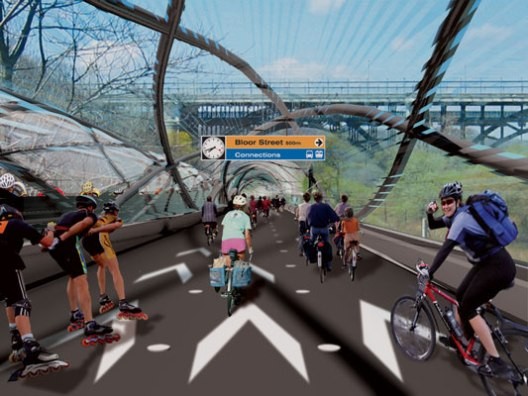Inventive Forms of Transport

City ziplines
Bulgarian architect Martin Angelov came up with the idea of installing city ziplines originally as a means of moving cyclists more efficiently from point A to point B. Known as the Kolelinia concept, it has now altered more into the idea of creating several ziplines that pedestrians could attach themselves to with the use of a battery-powered backpack. As outlandish as some of this may sound, it’s actually a very achievable technology. Of course, it would require proper investment. Who knows, in a few years the Kolelinia city zipline could be a very real thing somewhere in the world.
Velo-City
If you’re a cyclist, then you may be interested to hear about what is being done in Toronto, Canada. Essentially, Velo-City is a series of elevated bikeways that are encased in tubes that aim to allow cyclists to move from place to place in complete safety. By design, the tubes create natural tailwinds that would make transit simpler, quicker and safer. Still a mere concept, the hope is that Velo-City will eventually have its initial launch in Toronto. Roller skaters will be able to take advantage of the service as well.
SMART helicopters
As far as air travel goes, helicopters are usually used more for tour flights, medical emergencies, rescues and assistance during disasters. Besides this, they’re not that feasible for other tasks given the loud amount of noise pollution and how quickly they use up petrol.
In attempt to change this, NASA is currently working on a series of SMART technology helicopters that would be built to seat more people (up to 100), cause less noise and use up petrol at a much slower pace. Still very much in early tests, it will be interesting to see whether NASA can achieve the goal they’ve set out for themselves.
Rail cabs
Envisioned as the automated future of public transport, rail cabs are stated as being cheap to manufacture and that they would take advantage of current rail lines already laid down. As the name suggests, rail cabs would be like taxis and would seat only a few people. You’d enter into these cabs, input the destination you want to go to and it would take you there with absolutely no stops in the interim like a typical train would do.
Details such as how each rail cab would be able to move along the tracks without interfering with other cabs going in the same or opposite direction have not been clarified. However, apparently a series of sensors would help cabs see each other and prevent any crashes or other accidents (much in the same way automated vehicles utilise sensors crash-prevention technology).